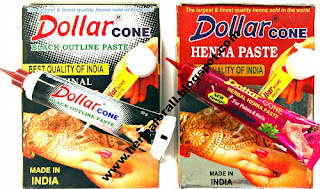Jamila Henna Powder is
obtained from fresh henna leaves. The leaves are then dried and
cleaned from its straws and dust. Then grinned in machines resulting in
powder form. During the process, the powder is further cleaned from its
impurities, if any, and finally a silk smooth powder is obtained which
is hygienic and safe to be used on human hair and skin. The Body Art
Grade is obtained by further grinding and sifting of that powder until
baby powder smoothness is obtained. This henna powder is super refined
and extremely high in dye contents and is packed in aluminium foils to
get best results up till 3 years.
How to mix Jamila Henna Powder:
HC "KISS" recipe
Begin 24 hours before you plan to use the henna
1.
Gather your Supplies
Jamila Henna Powder, 20 grams or 1/4 Cup
Bottled or Fresh Lemon Juice, strained
Small Plastic or Glass Bowl
Measuring Spoons
Sugar
Essential Oils, 1.5 teaspoons
Plastic Sandwich Bag
Applicator Bottle or Cone
This recipe is for 20 grams of fresh henna powder and will produce approximately 3 ounces of paste,
enough for 75 small patterns, 3-4 cones.
2. Pour 20 grams of fresh henna powder into a small bowl
3. Add 1/4 cup of strained fresh or bottled lemon juice.
When using any dye a second ingredient is needed to create the chemical
reaction to release the dye molecule. Henna requires an acid to bring
out the dye molecule contained within its leaves. Lemon juice is the
perfect companion as it is very acidic, readily available, and very
safe.
We do not recommended water to mix your paste. Some recipes call for
many ingredients such as coffee, tea, water, tamarind, dried limes,
cloves, and spices. None of these extra ingredients will make much of a
difference in the staining power of your paste. You'll get a fabulous
stain with just lemon juice and a great henna powder and high quality
essential oils.
4. Stir the henna and lemon juice until they are completely mixed
together and no lumps of dry powder remain. The paste will be thick,
similar to mashed potatoes.
5- Add Sugar and Essential Oil and Stir. It will be lumpy and chunky at first.
6- Keep stirring and It will smooth out and become silky
7- Cover the paste with plastic wrap. Press the plastic wrap against the surface of the paste expelling any air pockets.
8- Let the paste sit in a warm place, around 75 ° to 85° Fahrenheit,
for 24 hours to allow the dye to be drawn out of the henna leaves so it
will stain your skin deeply and as strong as possible.
9-You are waiting for the dye to be released from the henna leaves. If
you mix henna in a clear container it's easy to see the dye release.
This is an easy way to insure your henna is fresh and has good dye
content.
The dark band at the top shows where the dye has released.
10-After letting the henna mature for 24 hours it is ready to be used. Check and adjust your consistency if desired.
11-Determining exact amounts of lemon juice required for henna paste is
very difficult since the henna plants are grown in many different
regions of the world. Depending on the location, weather, and time of
year the leaves are harvested the recipe will need varying amounts of
lemon juice. The paste should be smooth and creamy, similar to yogurt.
If too much lemon juice is added the paste will be runny and your
designs will bleed together. If the paste is too thick it will be
difficult to squeeze the paste out of the applicator.
Add lemon juice 1/4 teaspoon at a time, mixing completely between each
addition, until you reach the desired creamy consistency.
When your paste is the perfect consistency fill your applicators.
Uses of Henna Powder:
Mehndi (Henna) has been in use in beauty rituals and customs from time
immemorial. History depicts its usage since Stone Age and it has
religious importance in almost every religion. It is the oldest
documented cosmetic, widely used in Near East and Middle East Asia and
North Africa.
Apart from its traditional use i.e. hair dyeing and hair conditioning;
its widely been used to decorate human body with desired temporary
patterns. Henna gives stunning impressions of dark red and reddish brown
colour on human skin with an advantage that a new pattern can be
enjoyed on the same skin after the first impression fades and disappears
after two to three weeks. It is not painful at all and gives a cool and
soothing feel, kills dandruff, stops falling of hair and leaves
refreshing fragrance due to its natural properties. It’s a proven
natural hair conditioner with having no side effects. Moreover, its
regular use prevents hair from falling, as it’s the best source of
killing dandruff.










